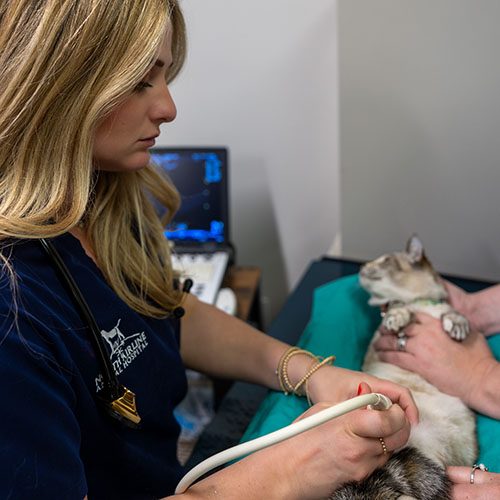Ultrasound
Pet ultrasound is a non-invasive diagnostic imaging technique that has revolutionized veterinary medicine. Utilizing high-frequency sound waves, it allows veterinarians to visualize internal structures of animals, including organs, tissues, and blood vessels, in real-time. This technology aids in the detection, diagnosis, and monitoring of various health conditions in pets.
From identifying pregnancies and monitoring fetal development to diagnosing abdominal issues such as tumors or organ abnormalities, ultrasound provides invaluable insights into the health of our animal companions.
Unlike X-rays, ultrasound does not involve radiation, making it safe for both pets and veterinary staff. Furthermore, it is generally well-tolerated by animals, requiring little to no sedation in most cases. This not only reduces the risk associated with anesthesia but also minimizes stress for the pet during the procedure.
Additionally, ultrasound can be performed quickly, allowing for immediate assessment and timely intervention when necessary. Pet ultrasound has become an indispensable tool in veterinary practice, facilitating early detection, precise diagnosis, and optimal management of medical conditions for your pets.

Book your dog or cat's appointment today!
Why is ultrasound a necessary diagnostic tool for pets?
Ultrasound is an essential diagnostic tool for pets because it provides a non-invasive, real-time method to assess internal organs, detect abnormalities, and guide treatment plans without the need for surgery. This imaging technique uses sound waves to create detailed pictures of the inside of the body, helping veterinarians diagnose a wide range of conditions in pets.
One of the key benefits of ultrasound is its ability to evaluate soft tissues, such as the heart, liver, kidneys, bladder, and intestines, which are difficult to examine with X-rays. It can detect conditions like tumors, cysts, infections, organ enlargement, or fluid accumulation. This allows for early detection of diseases, which is crucial for successful treatment and better outcomes.
Ultrasound is particularly useful in monitoring heart health, as it helps assess the heart's size, structure, and function. It’s also valuable in guiding procedures like needle biopsies, fluid removal, or guiding a catheter for drainage, reducing the risk of complications.
Additionally, ultrasound is safe and generally well-tolerated by pets, as it doesn’t involve radiation. This makes it a preferred option for repeated evaluations, particularly for chronic conditions or when ongoing monitoring is needed.
For pets with vague symptoms like vomiting, lethargy, or weight loss, ultrasound can help pinpoint the underlying cause, allowing for quicker diagnosis and treatment. It also provides vital information for planning surgeries or treatments, helping veterinarians make more informed decisions about the best course of action.
Overall, ultrasound is an invaluable tool in modern veterinary care, aiding in early detection, precise diagnosis, and more effective treatment of a wide variety of health issues.



